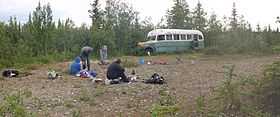Stampede Trail
The Stampede Trail is a road and trail located in the Denali Borough in the U.S. state of Alaska. A paved or otherwise improved road for 10 to 15 miles (16 to 24 km) on its eastern end, the remainder of the route consists of a primitive, remote and at times dangerous hiking trail, following a path where the original road had deteriorated.
Historically, access to the trail was gained typically from a siding of the Alaska Railroad, its original eastern terminus. The primary access to the trail has been from the George Parks Highway (Alaska Route 3) since its opening in the early 1970s. The Parks Highway intersects the trail at milepost 251.1, two miles north of the center of Healy. Though this intersection marks the present-day eastern terminus of the Stampede Trail, Lignite Road continues east from this intersection toward the railroad tracks and the Nenana River.
The Stampede Trail has been the subject of international attention since the 1992 death of Christopher McCandless, whose body was found in an abandoned bus deep inside the wilderness along the trail. First brought to the public's attention by Jon Krakauer in an Outside magazine article, a book and film followed. The latter led to an increase in hikers along the trail during the 21st century, as well as complaints of a corresponding increase in hikers who lack experience and subsequently require assistance in the backcountry.
History
The Stampede Trail began as the "Lignite to Kantishna" mining trail blazed in 1903 by prospectors drawn to the Kantishna region by the discovery of placer gold.[1] In the 1930s miner Earl Pilgrim[2] used the trail to access his antimony claims on Stampede Creek, above the Clearwater Fork of the Toklat River.
In 1960, Yutan Construction won a contract from the new state of Alaska to upgrade the trail as part of Alaska's Pioneer Road Program, building a road on which trucks could haul ore from the mines year-round to the railroad at Lignite. Construction was completed in 1961 after some 47.5 miles (76.4 km) of road was built but no bridges were ever constructed over the several rivers it crossed. Maintenance on the project was halted in 1963 and the route was shortly rendered impassable to the intended mining vehicles by thawing permafrost and floods.[3]
The trail has since been used by backcountry travelers on foot, bicycle, dog sleds, snowmachines, and all-terrain vehicles. The trail's main obstacle is the crossing of the Teklanika River. The river's fluctuating depth can hinder attempts to ford it. The Alaska State Troopers report several rescues are necessary every year at the river crossings and in August 2010, high water resulted in the drowning death of Claire Ackermann, a hiker from Switzerland.[4]
Bus 142

Fairbanks City Transit System Bus 142 is an abandoned 1946 International Harvester K-5 that is parked in a clearing along the Stampede Trail near Denali National Park. It was originally one of three buses used by the Yutan Construction Company to transport the construction crew from Fairbanks to the work site in 1961. The bus's engine was removed and it was instead towed by D8 Cats. Eventually, its axle broke which caused the crew to leave it where it now serves as a backcountry shelter for hunters, trappers and ranger patrols.
The bus gained notoriety in January 1993 when Outside magazine published an article written by Jon Krakauer titled "Death of an Innocent" describing the death of Christopher McCandless, an American hitchhiker who lived in the bus during the summer of 1992 while attempting to survive off the Alaskan wilderness only to die of starvation four months later.[5]
In recent years, the bus, also known as the "Magic Bus" according to McCandless's writings, has seen a pilgrimage of visitors seeking where McCandless perished. The 2007 film version of Jon Krakauer's 1996 book about McCandless, Into the Wild, has revived interest in the bus.
In 2013, Dave Gill from England visited the bus as part of a British documentary publishing project. The post on his website shows that as of July 8, 2013, the condition of the bus site, in particular the exterior of the bus, has diminished as visitors have shot at the bus and caused damage.[6]
References
- ↑ https://www.facebook.com/groups/stampederoad/306513786217627/
- ↑ http://alaskamininghalloffame.org/inductees/pilgrim.php
- ↑ https://www.facebook.com/groups/stampederoad/306513786217627/
- ↑ http://www.stampedetrail.info/trailreports2010.php
- ↑ http://outside.away.com/outside/features/1993/1993_into_the_wild_1.html
- ↑ http://www.vaguedirection.com/thestampedetrail
External links
- FreeWheelings - Complete Guide to Stampede Trail and Finding the Magic Bus including GPS Coordinates
- The Road Chose Me - Hiking The Stampede Trail to reach The Magic Bus, July 2009.
- Hiking The Stampede Trail - Resources and Information about Hiking the Stampede Trail to Bus 142 in Alaska
- A British Documentary visits the Magic Bus - Hiking The Stampede Trail to the Into The Wild Bus, July 2013.
http://kiwi-panamericana.weebly.com/blog/into-our-wild - Early spring 2014 hike to the bus